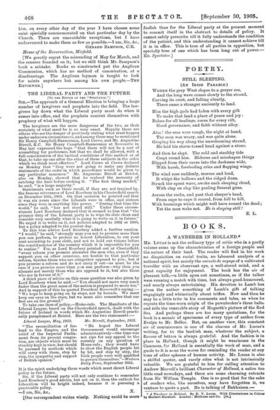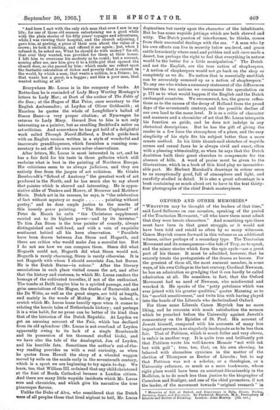Mn. LUCAS is not the ordinary type of critic who
in a portly volume sums up the characteristics of a foreign people and the nature of their land. The reader will find in his work no disquisition on racial traits, no laboured analysis of a national spirit, but merely the carnets de voyage of a cultivated traveller with an observant eye, a well-stored mind, and a great capacity for enjoyment. The book has the air of pleasant talk,—a little spun out sometimes, as if the talker were running a match with time, but always good-humoured, and nearly always entertaining. His devotion to Lamb has given the author something of Lamb's gift of talking engagingly and whimsically about trifles. Now and then he may be a little trite in his comments and tales, as when he repeats the time-worn origin of the pawnbroker's three balls, and tells the venerable story of Hogarth's picture of the Red Sea. And perhaps there are too many quotations, for the book is a mosaic of specimens of every type of author from Evelyn to Mr. Belloc. But, on another view, this constant air of reminiscence is one of the charms of Mr. 'Lucas's writing, for to the , bookish man, whatever the subject, a flavour of letters is always grateful. And the fashion is in place in Holland, though it might be wearisome in the Caucasus, for Holland is essentially the work of man, and a guide to it is none the worse for reminding the reader at any time of other spheres of human activity. Mr. Lucas is also a skilful quoter, and rarely cites what is not intrinsically valuable. We are grateful to him for calling attention to Andrew Marvell's brilliant Character. of Holland, a satire too little read nowadays, and there are some charming extracts from Sir William Temple. One is so good that for the sake of readers who, like ourselves, may have forgotten it, we venture to quote a part. He is talking of Enkhuisen Wanderer in Holland. By E. V. Lucas. With Illustrations in Colour by Herbert Marshall. London : Methuen and Co. [63.] "And here I met with the only rich man that ever I saw in my life; for one of those old seamen entertaining me a good while with the plain stories of his fifty years' voyages and adventures, while I was viewing their hospital, and the church adjoining, I gave him, at parting, a piece of their coin about the value of a crown ; he took it smiling, and offered it me again ; put, when I refused it he asked me, What he should do with money ? for all, that ever they wanted, was provided for them at their house. I left him to overcome his modesty as he could; but a servant, coming after me, saw him give it to a little girl that opened the church door, as she passed by him: which made me reflect upon the fantastic calculation of riches and poverty that is current in the world, by which a man, that wants a million, is a Prince; he, that wants but a groat, is a beggar; and this a poor man, that wanted nothing at all."
Everywhere Mr. Lucas is in the company of books. At Rotterdam he is reminded of Lady Mary Wortley Montagu's letters to Lady Mar ; at Dort of the author of The Fable of the Bees ; at the Hague of Mat Prior, once secretary to the
English Ambassador; at Leyden of Oliver Goldsmith ; at Haarlem he quotes the whole of Longfellow's ballad of
Simon Danz—a very proper citation; at Nymwegen he returns to Lady Mary. Gerard Dou to him is not only interesting as a painter, but-as recalling Beckford's satire on art criticism. And somewhere he has got bold of a delightful work called Through Noord-Holland, a Dutch guide-book
with an English version ,written in a style of wonderful and inaccurate grandiloquence, which furnishes a running com- mentary to set off his own more sober observations.
After letters, Mr. Lucas is most interested in art, and he has a fair field for his taste in those galleries which still enshrine what is best in the painting of Northern Europe. His criticisms seem to us always judicious, and they are entirely free from the jargon of art criticism. He thinks Rembrandt's "School of Anatomy" the greatest work of art produced in the North, and he has much else to say about that painter which is shrewd and interesting. He is appre- ciative alike of Tethers and Mauve, of Brouwer and Matthew Maris. Dutch art in its essence, he says, is "the celebration of fact without mystery or magic painting without
poetry," and he does ample justice to the merits of this homely genre painting. " The Store Cupboard" of Peter de Hooch he calls " the Christmas supplement carried out to its highest power—and by its inventor."
To him Jan Steen is the true painter of comedy, always distinguished and well-bred, and with a vein of exquisite sentiment behind all his keen observation. " Parallels have been drawn between Jan Steen and Hogarth, and there are critics who would make Jan a moralist too. But
I do not see how we can compare them. Steen did what Hogarth could not, Hogarth did what Steen would not. Hogarth is rarely charming, Steen is rarely otherwise. It is not Hogarth with whom I should associate Jan, but Burns. He is the Dutch Burns—in colour." After the literary
associations in each place visited comes the art, and after that the history and customs, to which Mr. Lucas renders the homage of the cultivated traveller, if not of the enthusiast.
The tombs at Delft inspire him to a spirited passage, and the grim associations of the Hague, the deaths of Barneveldt and the De Witts, as well as the great sieges, are told at length, and mainly in the words of Motley. Motley is, indeed, a crutch which Mr. Lucas leans heavily upon when it comes to relating the heroic tales of Netherlands history ; and perhaps it is a wise habit, for no prose can be better of its kind than that of the historian of the Dutch Republic. At Leyden we get an amusing account of the Fair, which has declined from its old splendour (Mr. Lucas is not overfond of Leyden apparently owing to its lack of a single Rembrandt and its possession of ten thousand stuffed birds), and we have also the tale of the Anabaptist, Jan of Leyden, and his horrible fate. Sometimes the author's out-of-the- way reading provides us with a real curiosity, as when he quotes from Howell the story of a wheeled waggon moved by sails on the sands early in the seventeenth century, which is a sport we are beginning to try again to-day. We learn, too, that William IIL ordained that any child christened at the font of Breda Cathedral became a London citizen. And there are many little wayside incidents which Mr. Lucas sees and chronicles, and which give his narrative the true picaresque flavour.
Unlike the Duke of Alva, who considered that the Dutch were of all peoples those that lived nighest to hell, Mr. Lucas
dogmatises but rarely upon the character of the inhabitants. But he has some wayside jottings which are both shrewd and witty. The Dutch-passion of interference, he thinks, comes from their successful dealings with the sea. " A man who by his own efforts can live in security below sea-level, and graze cattle luxuriantly where sand and pebbles and salt once made a desert, has perhaps the right to feel that everything in nature would be the better for a little manipulation." The Dutch and not the English, are the true nation of shopkeepers. " A nation of shopkeepers would not go back on the shop so completely as we do. No nation that is essentially snobbish can be accurately summed up as a nation of shopkeepers." To any one who wishes a summary statement of the differences between the two nations we recommend the speculation on p. 171 as to what would happen if the English and the Dutch exchanged countries. We recommend, too, the graver reflec- tions as to the causes of the decay of Holland from the proud days of the seventeenth century, and the possible decline of our own land to the same level. It is as a critic of character and manners and a chronicler of art that Mr. Lucas interprets his function as guide, and he does not indulge in any rhetorical descriptions. But he has the gift of giving the reader in a few lines the atmosphere of a place, and the easy simplicity of his style fits his subject better than a more ornate method. In his little thumb-nail sketches of wayside scenes and casual faces be is always vivid and exact, often with a pleasing whimsicality, as when he says that the Dutch doubtless built their great churches to compensate for the absence of hills. A word of praise must be given to the illustrations, which in a book of this kind play no inconsider- able part. Mr. Herbert Marshall's drawings in colour seem to us exceptionally good, full of atmosphere and light., and carefully studied in detail. It is also a great advantage in a book containing so much about art to have in the text thirty- four photographs of the chief Dutch masterpieces.











































 Previous page
Previous page